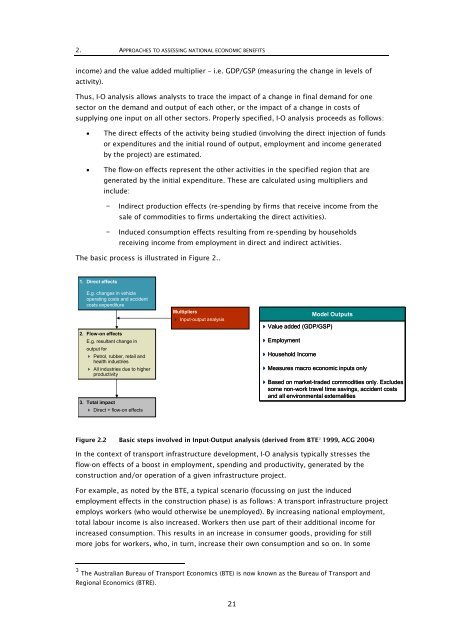Research 350 - NZ Transport Agency
Research 350 - NZ Transport Agency
Research 350 - NZ Transport Agency
You also want an ePaper? Increase the reach of your titles
YUMPU automatically turns print PDFs into web optimized ePapers that Google loves.
2. APPROACHES TO ASSESSING NATIONAL ECONOMIC BENEFITS<br />
income) and the value added multiplier – i.e. GDP/GSP (measuring the change in levels of<br />
activity).<br />
Thus, I-O analysis allows analysts to trace the impact of a change in final demand for one<br />
sector on the demand and output of each other, or the impact of a change in costs of<br />
supplying one input on all other sectors. Properly specified, I-O analysis proceeds as follows:<br />
• The direct effects of the activity being studied (involving the direct injection of funds<br />
or expenditures and the initial round of output, employment and income generated<br />
by the project) are estimated.<br />
• The flow-on effects represent the other activities in the specified region that are<br />
generated by the initial expenditure. These are calculated using multipliers and<br />
include:<br />
– Indirect production effects (re-spending by firms that receive income from the<br />
sale of commodities to firms undertaking the direct activities).<br />
– Induced consumption effects resulting from re-spending by households<br />
receiving income from employment in direct and indirect activities.<br />
The basic process is illustrated in Figure 2..<br />
1. Direct effects<br />
E.g. changes in vehicle<br />
operating costs and accident<br />
costs expenditure<br />
2. Flow-on effects<br />
E.g. resultant change in<br />
output for<br />
Petrol, rubber, retail and<br />
health industries<br />
All industries due to higher<br />
productivity<br />
3. Total impact<br />
Direct + flow-on effects<br />
Multipliers<br />
Input-output analysis<br />
Model Outputs<br />
Value added (GDP/GSP)<br />
Employment<br />
Household Income<br />
Measures macro economic inputs only<br />
Based on market-traded commodities only. Excludes<br />
some non-work travel time savings, accident costs<br />
and all environmental externalities<br />
Figure 2.2 Basic steps involved in Input-Output analysis (derived from BTE 3 1999, ACG 2004)<br />
In the context of transport infrastructure development, I-O analysis typically stresses the<br />
flow-on effects of a boost in employment, spending and productivity, generated by the<br />
construction and/or operation of a given infrastructure project.<br />
For example, as noted by the BTE, a typical scenario (focussing on just the induced<br />
employment effects in the construction phase) is as follows: A transport infrastructure project<br />
employs workers (who would otherwise be unemployed). By increasing national employment,<br />
total labour income is also increased. Workers then use part of their additional income for<br />
increased consumption. This results in an increase in consumer goods, providing for still<br />
more jobs for workers, who, in turn, increase their own consumption and so on. In some<br />
3 The Australian Bureau of <strong>Transport</strong> Economics (BTE) is now known as the Bureau of <strong>Transport</strong> and<br />
Regional Economics (BTRE).<br />
21
















